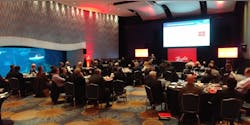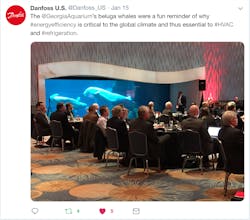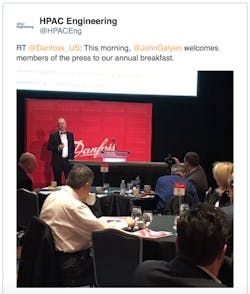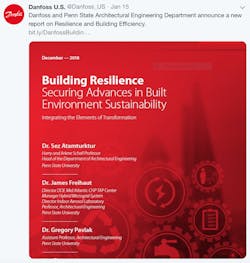'Big Fish' Danfoss Champions Resiliency on Multiple Levels
As the Georgia Aquarium's prized Beluga whales and manta rays swam past at Danfoss North America's 24th Annual AHR Expo Press Breakfast, cynical journalists could not help but wonder if a predator or two were lurking in the foggy far reaches of the liquid habitat. Coincidentally, the cheery talk of the HVACR market's current strength also came with a similar undercurrent of potential danger.
"The market seems pretty good right now, but things definitely look fuzzy toward the end of 2019," said a very frank John Galyen, president of Danfoss NA. "The market is at a cyclical high now, as well. So, given rising materials costs and ongoing tariffs, we just don't see that (high) continuing indefinitely."
At the same time, however, "we don't want to talk ourselves into a recession," Galyen cautioned. (For more from Galyen, see our interview with him in the current issue of HPAC Engineering.)
Resiliency toward market conditions also paralleled the event's focus on resilience as an increasingly important factor in the HVACR industry.
Amid a regulatory update and short presentations of case studies on such subjects as "Achieving Low GWP in Supermarkets" and "High Lift Solutions for Air-Cooled Chillers", Danfoss also distributed its new research document released just last month by Penn State University's Dept. of Architectural Engineering. Entitled "Building Resilience: Securing Advances in the Built Environment," the report represents a continuing collaboration between Danfoss and Penn State, which also produced a 2017 study, "High Performance: Making the Building-Energy Equation Sustainable," for the United Nations Economic Commission for Europe.
"Resilience has now become integral to life quality within the built environment and is consequently an important element in the overall sustainable energy equation," writes Scott Foster, director of the Sustainable Energy Division for the UN Commission. His words appear in the preface to the new report, which can be downloaded here.
AN EXCERPT FROM THE INTRODUCTION:
The five most costly Atlantic hurricanes have occurred since 2005, according to the United States National Hurricane Center. They impacted a region from the Caribbean north to the east coast of Canada, across to Mexico and up through Texas, the Gulf Coast, and inland. Sea level rise is now impacting property values on the Mississippi Coast, and Charleston, South Carolina, is experiencing ever more frequent flooding. These items are but a sliver of the changing conditions being witnessed across the country and around the world.
Strategists, practitioners, urban officials, and others have responded with a focus on resilience—the capacity of a built environment to take a major hit from an extreme event and remain or return quickly to being operational. There is much at stake. First, lives are at risk. Beyond that, the costs of restoration, of lost production and productivity all mount quickly. There is also the future cost of lost confidence, as workers and investors seek opportunities in more secure places. Resilience is a strategy to contain risk, but also to secure prosperity.
Priorities do not always easily align, and resilience is no exception. It is not difficult to see resilience as an element of sustainability, a goal ever more widely recognized as essential to progress. But it is also possible to observe potential tensions between resilience and other important dimensions of sustainability, such as energy efficiency and even health and well-being.
Integrating the elements of sustainability is vital to the successful transformation that will be required in the 21st Century. Local and national governments have an important role to play in that transformation and need to adopt policies that will drive action on climate and energy. But integration will also require an emphasis on creative design.
To the extent that much of the low hanging fruit of sustainability has already been picked, strategy has entered an Era of Complexity. Each thread in the sustainability fabric is intricate, with its unique demands and specifications. However, the overall goal—for industry, finance, policy, research, and advocacy—is to weave those disparate threads into the single tapestry of a comprehensive and sustainable built environment of a sort never before seen. Physics will be important, as will new technologies; digitalization linked to heating and cooling will be critical to building energy optimization and resilience. But art and collaboration are being demanded of professions more accustomed to production, delivery, and operation.
To read the full report, click here.
About the Author
Rob McManamy
Editor in Chief
An industry reporter and editor since 1987, McManamy joined HPAC Engineering in September 2017, after three years with BuiltWorlds.com, a Chicago-based media startup focused on tech innovation in the built environment. He has been covering design and construction issues for more than 30 years, having started at Engineering News-Record (ENR) in New York, before becoming its Midwest Bureau Chief in 1990. In 1998, McManamy was named Editor-in-Chief of Design-Build magazine, where he served for four years. He subsequently worked as an editor and freelance writer for Building Design + Construction and Public Works magazines.
A native of Bronx, NY, he is a graduate of both the University of Virginia, and The John Marshall Law School in Chicago.
Contact him at [email protected].



